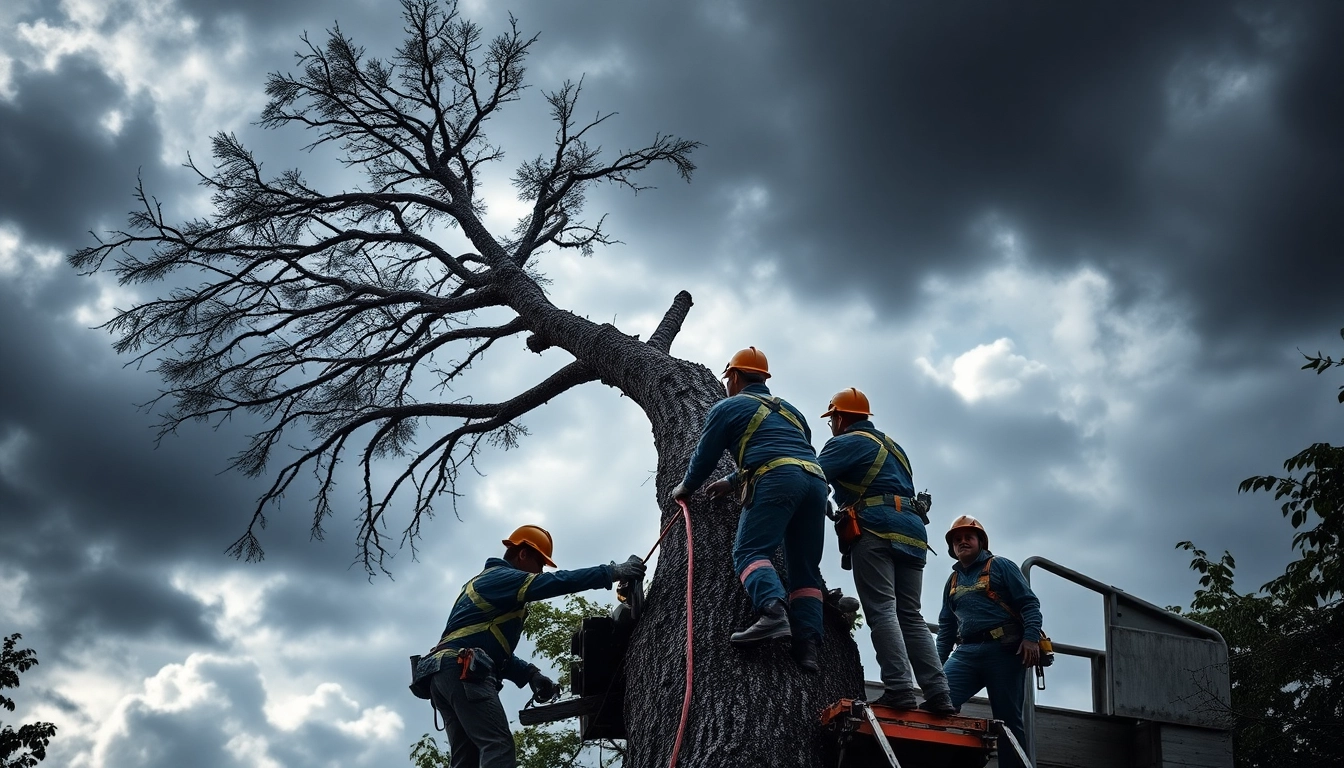
Understanding Emergency Tree Service
Trees contribute significantly to the aesthetics and health of our environment; however, they can also pose serious risks during adverse weather events or due to natural decay. Emergency tree services exist to address situations where trees become hazardous. These services are critical in ensuring the safety of your property and the surrounding area. Understanding when and how to engage an emergency tree service can save property and potentially lives.
What Constitutes an Emergency Tree Situation?
An emergency tree situation can arise from various circumstances, primarily involving risk to health and safety or property. Common indicators include:
- Fallen Trees: Trees that fall on buildings, cars, or power lines are immediate emergencies.
- Leaning or Cracked Trees: Trees that exhibit severe leaning or physical damage may fall at any moment, necessitating urgent action.
- Branches Causing Obstruction: Overhanging branches that threaten to break or fall, especially during storms, are a cause for concern.
- Visible Pests or Disease: If a tree is infested with pests or showing signs of disease, it may require immediate attention to prevent further spread or collapse.
When to Call for Emergency Tree Services
Knowing when to call for emergency tree services can prevent small issues from escalating into significant problems. Consider calling if you observe the following:
- Severe weather warnings are in effect and could compromise tree stability.
- A tree has recently fallen and poses a risk to life or property.
- A tree’s roots are visibly exposed or damaged.
- Large branches are precariously hanging and could fall, especially during strong winds.
- A tree’s condition suddenly worsens, indicating potential structural failure.
Common Types of Tree Emergencies
Tree emergencies come in various forms, often demanding immediate attention from tree care professionals. Here are some common emergencies:
- Storm Damage: Significant wind, rain, or snow can cause substantial damage to trees, leading to falling branches or uprooted trees.
- Tree Collapse: Naturally compromised trees can suddenly collapse without warning, often due to internal rot or disease.
- Utility Interruptions: Trees that interfere with power lines can lead to outages and pose risks to public utilities.
- Roadway Hazard: Trees obstructing roadways require immediate removal to prevent traffic accidents.
How Emergency Tree Services Work
Initial Assessment Process for Emergencies
The first step when an emergency tree service arrives on the scene is conducting a thorough assessment of the situation. This involves:
- Safety Evaluation: Assessing risks to both the team and the surrounding area before commencing work.
- Degree of Damage: Evaluating whether the tree can be salvaged or if it poses a continued risk that necessitates removal.
- Environmental Factors: Taking into account the weather conditions and any potential for further damage.
Tools and Equipment Used in Emergency Tree Services
Effective emergency tree services rely on specialized tools that ensure safety and efficiency. Common tools include:
- Chainsaws: Essential for cutting through large branches or trunks swiftly.
- Wood Chippers: Used to convert branches and debris into mulch for easier disposal.
- Stump Grinders: Employed to remove tree stumps after tree removal.
- Safety Gear: Helmets, gloves, goggles, and other protective gear are mandatory to keep workers safe.
Steps Taken During an Emergency Tree Removal
When emergency tree removal is necessary, professional services follow a series of steps to ensure the job is done safely:
- Site Preparation: Establishing a safe working perimeter and setting up barriers if needed.
- Controlled Cutting: Using chainsaws and other tools to carefully dismantle the tree from the top down.
- Clearing Debris: Removing branches and trunk pieces to avoid additional hazards.
- Final Inspection: Consulting with the client to ensure satisfaction and discuss any follow-up actions.
Choosing the Right Emergency Tree Service Provider
Key Qualifications to Look For
Selecting a reliable emergency tree service provider is crucial for ensuring that the job is done safely and effectively. Key qualifications to look for include:
- Certification: Verify that the company and its staff are certified by a recognized arborist organization.
- Insurance Coverage: Ensure the service is fully insured to protect you from liability in case of accidents.
- Experience: Choose a provider with demonstrated experience in handling various tree emergencies.
Questions to Ask Your Emergency Tree Service
When vetting potential emergency tree services, it’s important to ask the right questions:
- What is your response time for emergencies?
- Do you have specialized equipment for safely removing large or dangerous trees?
- Can you provide references from previous clients?
- What safety protocols do you have in place for your staff?
Reading Reviews and Recommendations
Online reviews and personal recommendations can offer invaluable insight into the quality of a tree service. Look for:
- Consistent Positive Feedback: Customer reviews that highlight reliability, efficiency, and professionalism.
- Response to Negative Reviews: How the company addresses complaints can reflect its commitment to customer service.
- Local Reputation: Recommendations from neighbors or within the community can be a good indicator of trustworthiness.
Preventing Tree Emergencies Through Maintenance
Regular Tree Inspections and Health Checks
Preventive maintenance is vital in avoiding tree emergencies. Regular inspections can uncover underlying issues before they escalate into serious problems. Tree professionals recommend annual health checks, focusing on:
- Checking for signs of disease, decay, or infestation.
- Assuring proper pruning practices to maintain strong tree structure.
- Evaluating the tree’s root system for stability.
Significant Signs of Trees Needing Attention
Homeowners should be vigilant about certain warning signs that indicate a tree may need professional care:
- Discolored or Wilting Leaves: This can indicate stress, disease, or nutritional deficiencies.
- Unusual Growth Patterns: Stunted growth or irregular branching may suggest that a tree is struggling.
- Visible Cracks or Cavities: These can compromise tree health and increase the risk of collapse.
Creating a Sustainable Tree Care Plan
Establishing a sustainable tree care plan contributes significantly to minimizing emergencies. This plan should include:
- Regular Maintenance Schedule: Establish a timeline for routine inspections and necessary treatments.
- Emergency Preparedness: Create a plan outlining whom to contact in case of a tree emergency in your vicinity.
- Education: Stay informed about tree health and care techniques through workshops or local resources.
Understanding Costs Associated with Emergency Tree Services
Factors Influencing Emergency Service Costs
The costs associated with emergency tree services can vary widely, depending on several factors, including:
- Severity of the Situation: High-risk situations often demand more skilled labor and advanced equipment, impacting overall costs.
- Location: Accessibility issues can raise mobilization and operational costs, especially if a tree is situated in a hard-to-reach area.
- Time of Service: Emergency calls during off-hours or weekends may incur higher charges.
Comparing Quotes from Various Providers
Before choosing an emergency tree service, comparing quotes can help ensure you’re getting a fair price. Factors to consider include:
- Detailed Estimates: Ensure quotes include itemized costs for labor, equipment, removal, and cleanup.
- Warranty and Follow-Up Services: Consider any guarantees offered for their work, especially regarding tree health checks post-removal.
- Customer Support: A responsive and helpful customer service experience often correlates with higher quality service.
Insurance and Emergency Tree Services: What You Need to Know
Understanding how insurance applies to emergency tree services is crucial for homeowners:
- Homeowner’s Insurance: Check if your policy covers damages caused by fallen trees and removal costs.
- Documentation: Take photos and document costs associated with the situation, as this can support your claim.
- Deductibles: Be mindful of the deductible amounts that may apply when filing a claim.







